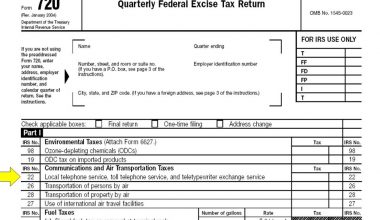Your “adjusted gross income” (AGI) is your “gross income” minus the deductions you’re eligible for. The United States Internal Revenue Service (IRS) utilizes this metric to determine a taxpayer’s tax obligation. If you know your AGI, you may calculate your taxable income after taking into account the various tax breaks to which you may be entitled. Read further to get to know more about how to calculate adjusted gross income for self-employed. We also added some steps on how to calculate adjusted gross income with W2 and taxes. Let’s dive in now!
What is Adjusted Gross Income?
If you want to know how much federal income tax you owe or if you qualify for any tax credits or deductions, you just need to look at your Adjusted Gross Income (AGI). You don’t have to fork over a certain amount of money out of every dime you earn in taxes. To avoid paying too much in taxes, it’s possible to reduce your taxable income by making certain modifications. The impact of these deductions on your tax return is distinct from the impact of either itemized or basic deductions.
Above-the-line adjustments include all deductions and other factors that have an impact on your Adjusted Gross Income. Below-the-line adjustments, on the other hand, include things like itemized deductions and credits that affect your income tax later on.
What is Included in AGI?
The following are included when you want to calculate your adjusted gross income:
- The sum of all of your taxable income is your AGI.
- Pay or salary
- Profits from Independent Work
- Dividends and interest from banks
- Alimony
- Financial gains
- Welfare and pension payments
- Other Withdrawals from Retirement Accounts
How to Lower Your AGI
Your taxable income can be reduced by the number of payments you make during the year. These benefits can help lower your adjusted gross income because they are not considered taxable income. Tax breaks at the top of the form include things like:
- Contributions to an Individual Retirement Account (IRA) or a Self-Employed Retirement Account (SEP)
- Money put into health savings accounts
- Insurance premiums for the self-employed
- Supplemental taxes for independent contractors
- Interest Costs on Student Loans
- Expenses for Eligible Teachers
- Costs associated with military relocation
- Divorce decree alimony payments made before 2018
Is AGI Calculated Before or After Taxes?
You need to calculate your adjusted gross income before you decide whether to use standard or itemized deductions. When doing your taxes, you should start with your gross income, then calculate your adjusted gross income for taxes, and then arrive at your taxable income.
See below for definitions of each of those terms:
Gross income: Your yearly earnings, which include everything from salary and pay to profits from a business or investments in retirement funds and stock gains.
Adjusted gross income (AGI): Your take-home pay after taking certain deductions (see below). The first step in determining taxable income is to determine one’s adjusted gross income.
Taxable income: Your adjusted gross income less any tax credits and either standard or itemized deductions. The IRS uses taxable income to determine your tax bracket and rate.
How to Calculate Adjusted Gross Income for Self Employed
The following are some steps to calculate adjusted gross income for self-employed:
#1. Track Down Your Financial Statements
Gathering your income statements is the first step to calculating adjusted gross income for self-employed. Everything from your W-2 for salary and wages to your self-employment tax returns and 1099s for other sources of income. Don’t forget to factor in any additional taxable income you receive; doing so will help you arrive at an accurate annual income figure. Other forms of income and whether or not they must be reported can be seen below.
#2. Taxable Income
Your taxable income is the amount of your total income that is subject to taxation by the Internal Revenue Service. It includes both monetary gains and losses. The following are examples of taxable income that is subject to taxation:
- Capital Gains from a Business
- Collective bargaining rights
- Acreage Profits
- Early retirement benefits for long-term disability
- State and local income tax refunds, credits, and deductions
- Rental payments and security deposits
- Pay for jury duty
- Compensation awarded in cases of workplace discrimination
- Awards, trophies, prizes, lottery, gaming, and other wins
- Rents, royalties, trust distributions, and partnership profits.
- Salary replacement
- Financial gains
- Benefits for the Unemployed
- Spousal maintenance
#3. Nontaxable Income
What is meant by “nontaxable income” is money that doesn’t have to be reported to the government. Although the IRS does not tax these payments, you must still report them on your tax return. Non-taxable income includes the following items:
- Money for the kids
- Insurance payments for injured employees
- Cash Payments for Disabled
- Unless you pay the insurance company, you won’t get access to the money from your policy’s death benefit.
- Funding for foster care
- Awards such as fellowships and scholarships
- Intentional debt forgiveness is given to you as a present
- The sum of money or other valuables you’ve gotten as a gift or inherited
- Profit from the sale of your primary residence is considered capital gain.
- You can move your retirement savings from one retirement account to another by executing a trustee-to-trustee transfer.
#4. Calculate Your Total Annual Income
After compiling your financial statements, you can figure out how much money you made last year. To do this, add up all of the money you expect to make in a year. In addition to your regular salary, you should include any incentives you earn. If you get paid an annual wage, your boss often handles the bulk of your responsibilities.
If you get paid by the hour, you can find out how much money you made by looking at your cheque or by multiplying your hourly income by the number of hours you worked per week and then by 52. The whole amount is your yearly salary. If you and your spouse are filing a joint tax return, then both of your annual incomes, including any bonuses, must be reported.
#5. Take the Sum of Your Deductions
Think about some of your deductions and costs. Some of the expenses you write off against your annual income could shift while others remain constant. Here are some common ways in which people reduce their gross income and arrive at their adjusted gross income:
- Deposits into Health Savings Accounts
- Insurance costs for those who are self-employed
- Cost of Education
- Cost of tuition
- Interest on Student Loans
- Paid Alimony
- Funding for schools
- Accounting for Your Own Taxes
- Penalty on the early withdrawal from your savings account
- Relocation costs
- Certain Payments to Individual Pension Plans
- Expenses unique to your company
Make sure you follow the rules before factoring in these deductions, as doing so may affect the outcome of your calculation. Also, you can’t write off everything from your AGI. After deciding which costs can be subtracted from your gross income, tally them all up.
#6. Subtract Your Deductions from Your Total Annual Income
To calculate your net annual income, take the sum of your annual income and your annual deductions and remove the result from 100. However, your yearly AGI will be the end outcome. This is how the equation is written out:
AGI = Total annual income − Eligible deductions
You can convert this yearly amount into a monthly amount by dividing it by 12. Various variables mean that this estimate could shift. Extra hours worked or a larger bonus is two examples of such variables.
What is an AGI Example?
Suppose you will have the following sources of income and expenses in 2023:
- Your yearly salary was $60,000, and your IRA distributions added another $2,000.
- You put $3,000 into your IRA that year and $2,500 toward paying down student loan interest.
On the basis of the facts presented, here is how you would calculate AGI:
Gross Income: Compute your total earnings. Both salary and IRA distributions count toward this total. Employment income of $60,000 plus IRA withdrawals of $2,000 equals $62,000.
Total Deductions: Add up all of the above-the-line deductions. In this situation, both the IRA contribution and the interest on the student loans can be written off. For the 2023 tax year, you cannot claim a deduction for moving costs. Interest on student loans ($2,500) plus IRA contributions ($3,000) equals $5,500.
Adjusted Gross Income: Find your net income by deducting all your expenses. $62,000 in gross income – $5,500 in total deductions = $56,500.
Therefore, your adjusted gross income for 2023 will be $56,500. Remember that this is just a simplified example, and that real-world computations can involve many more variables.
How to Calculate Adjusted Gross Income with W2
Your W-2 does not include your adjusted gross income, but it does include some of the data you’ll need to complete your 1040 to calculate your AGI. Your “wages, tips, and other compensation,” or taxable income from that employer, will be listed in Box 1 of your W-2. Calculate adjusted gross income with w2 after taking into account certain deductions that are not itemized in Box 1. In other words, your health savings account contributions and student loan interest are not included in the total “wages, tips, and other compensation” that you get.
Even more so, if you split your time between two different companies or change employment during the year, you should expect to receive multiple W-2s (one from each company). Income from sources other than a W-2, such as rental properties you own, may also be taxed.
How to Calculate Adjusted Gross income From Your W2
In order to calculate your Adjusted Gross Income (AGI), you can utilize the figures included in Box 1 of your W-2 to complete line 1a of your 1040, which is labeled “Total amount from Forms(s) W-2.” Following this step, Form 1040 will guide you through calculating your Adjusted Gross Income (AGI) by combining all of your income (including 1099 revenue, tips, and Social Security benefits) and deducting all of your deductions.
Where is AGI on a tax return?
Your adjusted gross income can be found on line 11 of your tax return (1040) with the Internal Revenue Service. In many cases, your tax liability will be determined by your AGI. The amount that is subject to tax is calculated by making the following changes and deducting the following items: Your taxable income is the sum shown. Also, the term “adjusted gross income (AGI)” will appear in various places on your tax returns.
Many tax breaks and credits are calculated based on your adjusted gross income. Unreimbursed medical costs, for instance, can be tax deductible if they exceed 7.5% of your adjusted gross income. The deduction is proportional to your adjusted gross income. Eligibility for the earned income tax credit, a refundable tax benefit for the low-income, is likewise based on AGI and earned income. Your federal adjusted gross income may also serve as the basis for your state’s tax return.
What Is Modified Adjusted Gross Income?
When deductions and tax-exempt interest income are factored in, the resulting figure is a household’s modified adjusted gross income. Similar to adjusted gross income (AGI), but with the addition of specific deductions, this income computation is used for tax purposes. If you want to know if you qualify, look at your MAGI.
- Investing in one’s future with a Roth IRA contribution.
- In regards to the Health Insurance Premium Tax Credit
- If your company offers a retirement plan, you can deduct your IRA contributions.
- To qualify for Medicaid or other government-subsidized health plans offered via the health insurance exchange
- Regarding tax breaks for students and working families
If you want to avoid paying penalties and interest for overpaying into these and other programs, figuring out your MAGI is a good place to start. Your eligibility for several government programs may also be determined by your MAGI.
How to Calculate Modified Adjusted Gross Income
- Determine how much you made
- Calculate your adjusted gross income
- Add back any deductions or expenses to your adjusted gross income
What Is the Adjusted Gross Income Formula?
It’s not too complicated to calculate your AGI. Simply add all sources of income together, then remove any tax credits or deductions using the income tax calculator. Your adjusted gross income (AGI) can be zero or negative if certain conditions are met.
How to Calculate Adjusted Gross Income with Standard Deduction?
It is necessary to first determine the total amount of income that is subject to taxation. Then, you’ll need to figure out how to adjust your income for things like deductible IRA contributions and self-employment tax credits. Take these expenses into account when calculating your taxable income.
How Do I Calculate My Adjusted Gross Income on My W2?
W-2 forms do not reveal AGI. Form 1040 is where you’ll figure out your AGI for the year. W-2 earnings are included in your AGI. But those numbers aren’t the only considerations.
What Is Adjusted Gross Income vs Net Income?
Your “net income” is the amount of money you really get to keep after paying all of your bills and taxes. Don’t get this confused with your adjusted gross income, which is the amount of money left over after you’ve claimed all of your tax deductions for the year.
Why Is It Called Adjusted Gross Income?
Net income, or disposable income, is the amount of money left over after taxes and other deductions have been taken off. Adjusted gross income (AGI) is derived from gross income by subtracting from it the effects of certain tax breaks provided by the IRS.
Final Thoughts
You should be able to finish your tax return with greater care and precision now that you have a better grasp of adjusted gross income. The stakes are enormous, so give yourself plenty of time to do a good job. If you need more time to file your business taxes with the level of detail and accuracy you need, you can request an extension from the Internal Revenue Service. You will now have an additional six months to compile and submit the necessary documentation. You should work with a tax expert since they will help you minimize your tax liability.
Related Articles
- SELF EMPLOYED INCOME TAX: Definition, Rate, How to Calculate & File for Return
- WHAT IS AGI: Meaning, How to Calculate It & Important Tips to Know
- ADJUSTED GROSS INCOME (AGI): Definition, Calculation, Effects on Taxes & Difference
- GROSS INCOME: Meaning, Formula & Difference






